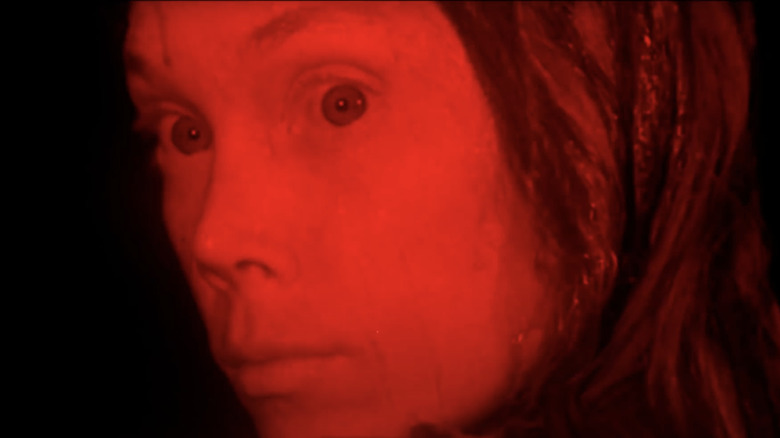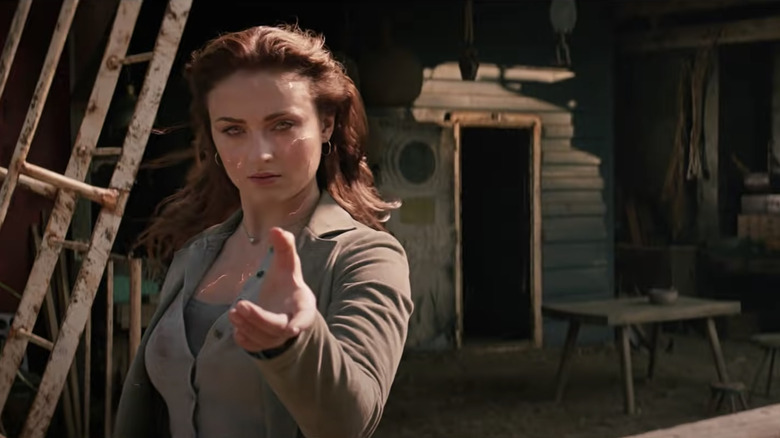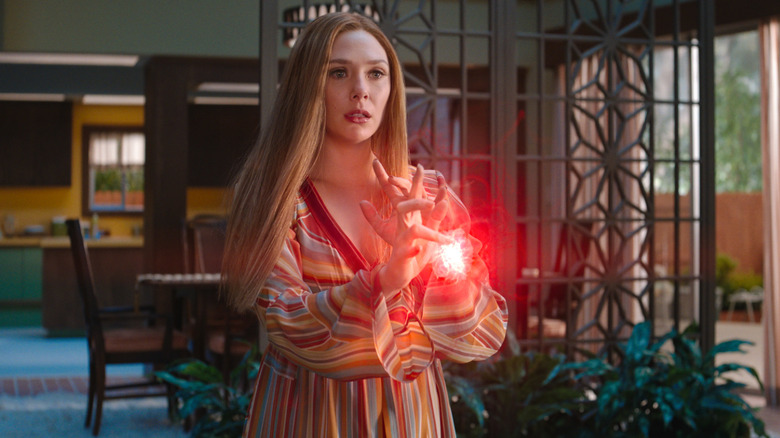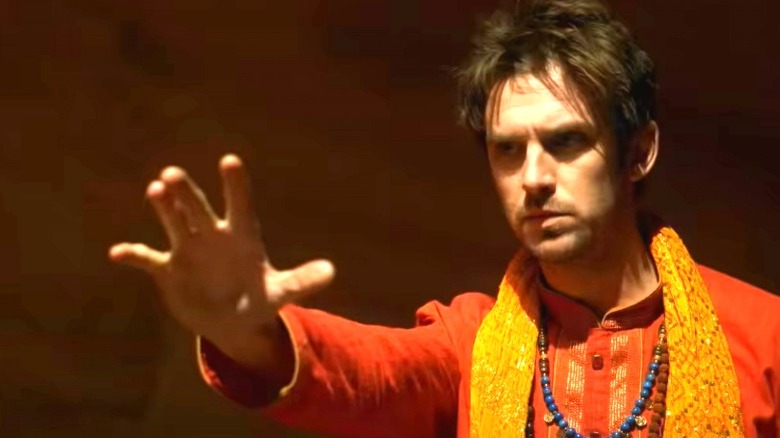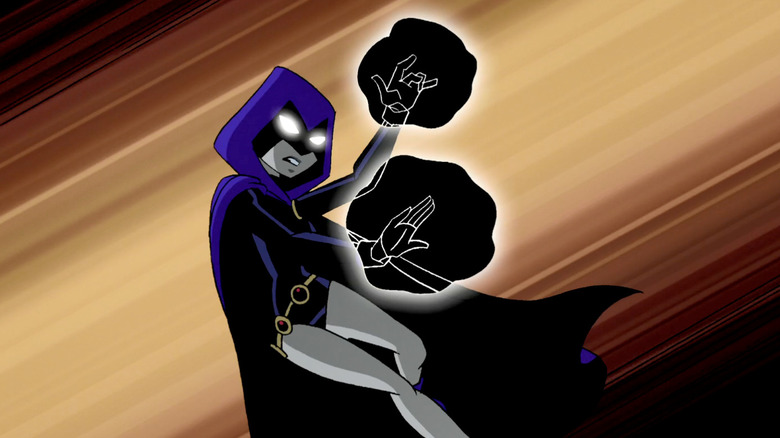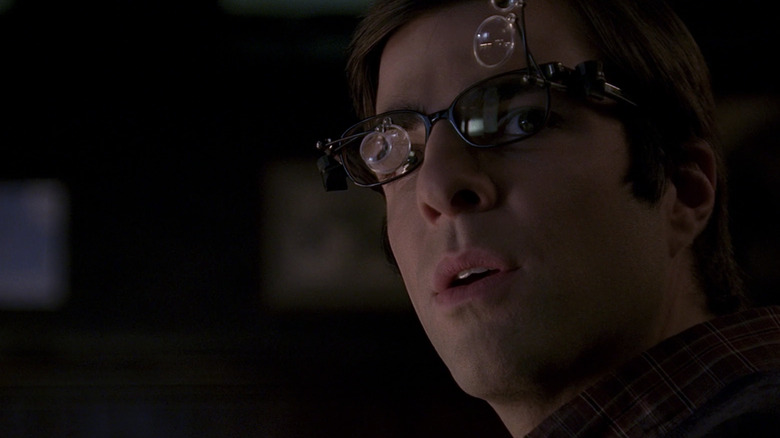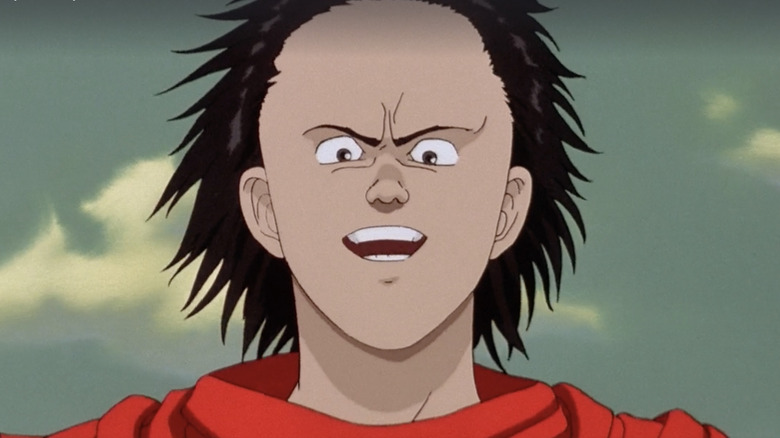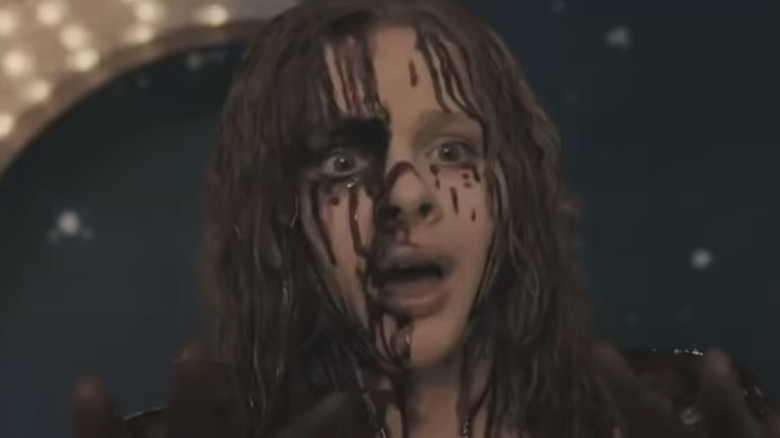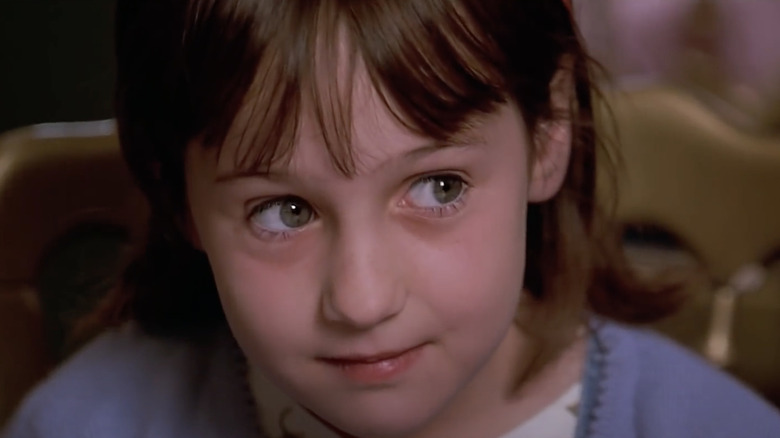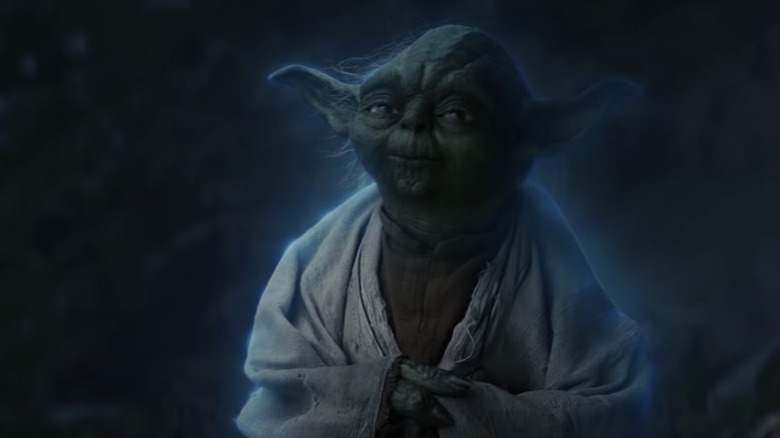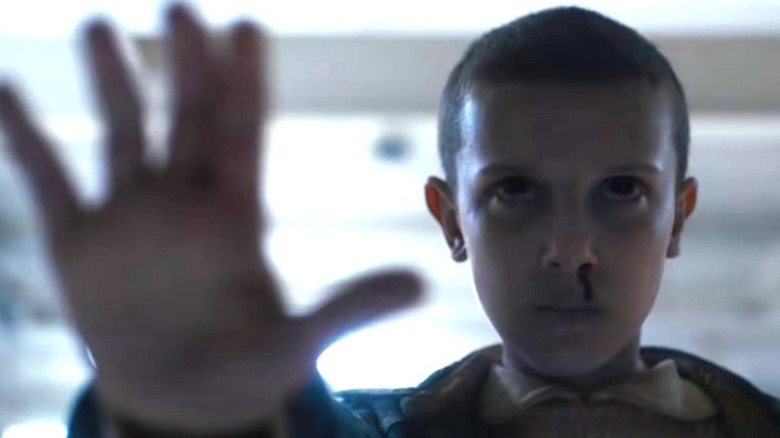The Best Movies And TV Characters With Telekinesis
The concept of telekinesis holds a fascinating place in the history of human imagination, residing almost exactly at the place where the clear impossibility of fiction bleeds into the unrelenting firmness of reality. While mythological figures who could manipulate physical objects from a distance have existed since at least 400 B.C., telekinesis as we think of it in modern fiction originates in real-life pseudoscience. The term was first used in 1890 by a Russian writer and researcher named Alexander Aksakov, who was fascinated by the idea of psychic abilities.
In the 1930s, this interest was picked up by the American J.B. Rhine, who fathered the supposedly scientific field of parapsychology — which also included telepathy, precognition, and extra-sensory perception — taking these powers out of the hands of ancient gods and spirits and positing a scientific explanation for them. Parapsychology has been roundly discredited, but it lasted long enough to become a staple of American science fiction during the so-called "Golden Age" of the 1940s and 1950s, influencing a massive generation of young readers and fundamentally altering the foundations of genre fiction and comic books.
The result is a film and television landscape that hands out telekinesis to its characters like candy. The question is, which of these psychically endowed figures stand out above the rest? Which are the most interesting, the most iconic, the ones you think about when you hear the phrase "mind over matter"? It's time to find out.
Jean Grey
In 1963, during a time when superhero comics were transitioning away from pulp and toward a more scientifically-grounded approach just as science fiction had two decades earlier, Stan Lee and Jack Kirby hit upon an origin story that was both broadly scientific and devastatingly simple: The heroes have powers simply because they are born with them. These now-famous mutants are the X-Men, and one of the founding members is the telekinetic Jean Grey (known originally as Marvel Girl, and occasionally later as Phoenix).
The parapsychological account of telekinesis fits so well with the idea of mutants as the next evolution of humanity that she's one of dozens to have this power. Jean, however, stands among the most iconic telekinetics in comic history, largely thanks to her tendency to die and be reborn. She's also among comics' most popular characters and has been featured in numerous "X-Men" adaptations, including the classic 1992 animated series and both incarnations of the 20th Century Fox film series.
Arguably no adapted version of Jean Grey has ever truly done her justice — she's notably sidelined in the 1992 show in favor of more recent additions to the "X-Men" canon like Storm and Rogue — but with Disney's purchase of Fox and reacquisition of the X-Men, Phoenix could rise again.
Wanda Maximoff
When Jean Grey inevitably makes her way into the Marvel Cinematic Universe, she won't be the only telekinetic on site. Wanda Maximoff — officially known as the Scarlet Witch in the MCU since "WandaVision" — has been throwing stuff around with the power of her mind since her debut in 2015's "Avengers: Age of Ultron." Like Jean, Wanda was originally a mutant in the comics, but as mutants don't exist (yet) in the MCU, her powers are the result of some unexplained combination of magic and the Mind Stone.
However, those powers still manifest themselves primarily in the form of telekinesis. She can affect people's minds from the beginning, and by the end of "WandaVision," she can do all sorts of other things — with promises of more to come — but she still relies a lot on tossing things around. The fact that she's the MCU's most prominent telekinetic and also some sort of mythical queen of Chaos Magic only serves to cement her upper-echelon position in the ranks of the Avengers.
That said, given her comparatively marginal role in the Infinity Saga, Wanda might not have been a compelling enough character to make this list in a pre-Disney+ world. She just never got enough screen time. "WandaVision" changed that, transforming the Scarlet Witch into a flawed but spellbinding woman struggling with the weight of her grief. Now, she's one of the stars of the MCU and arguably telekinesis' foremost representative in the world of streaming television.
David Haller
David Haller, the main character of FX's bleakly psychedelic "Legion," is another telekinetic sprung from the pages of Marvel Comics. For the record, though he's on a list of best telekinetic characters, calling David a "best" anything isn't meant to imply that he's a good person. By the end of Season 2, he's explicitly the villain of "Legion" after sexually assaulting his romantic interest, Syd Barrett.
We see his complex character from all possible angles over the course of three time-hopping, reality-warping seasons, which take their exploration of David's character to chaotic and abyssal depths. Reasonable minds may differ on whether or not he deserves redemption, but you can't say he's not interesting.
He's also, as it happens, one of the most powerful characters ever to grace a television screen. Telekinesis is the first ability he manifests, and the one we associate with him upon his initial introduction, but over the course of the series he displays the ability to bend reality itself — matter, energy, space, and time — to his will, along with the minds of those around him. Of course, this is all a loose adaptation of the comic book version of David Haller, whose mind consists of multiple personalities, each with its own powers. Both versions of the character are the son of Charles Xavier, but the one played by Dan Stevens in "Legion" is a uniquely compelling take.
Raven
Like Marvel, DC Comics has a plethora of characters with telekinetic powers. Unlike Marvel's, however, few of those characters are prominent enough to have had major roles in film and television adaptations of DC material, especially in a world where the closest we've gotten to a live-action Martian Manhunter is the last scene of the "Justice League" Snyder Cut.
In the realm of animation, however, one DC telekinetic has proven to be an incredibly popular and fantastically layered character since her arrival in 2003: Raven, the goth teen half-demon from Cartoon Network's "Teen Titans" and "Teen Titans Go!" While the shows' ensemble format and light-hearted tone make it difficult to regularly highlight the complexity of her character, when it does happen, she (ironically) shines — particularly in Season 4 of the original series, which centers on Raven's family and inner conflict.
Similar to Wanda Maximoff in the MCU, Raven is a character whose comic book incarnation doesn't emphasize telekinesis, but whose powers manifest primarily in the form of telekinesis onscreen. It's certainly not all she can do, and the power is fueled by her magical heritage rather than a parapsychological or evolutionary explanation, but it is definitely what she spends most of her time and energy on in combat scenarios. The influence of the animated Raven as a telekinetic icon can be seen in the fact that the 2018 live-action series "Titans" has Raven manifest telekinetic powers in the very first episode.
Sylar
Originally the central villain and later one of the chief protagonists of the NBC drama "Heroes," Sylar is the only character on this list whose telekinetic powers weren't given to him by an accident of birth or destiny. They were actively stolen. "Heroes" operates under the same basic mutant logic as "X-Men," but telekinesis isn't Sylar's mutant power: His power is to steal abilities from other mutants, killing them in the process. As a result, like many of these characters, telekinesis is just one of many skills Sylar possesses.
Despite this fact, it remains a power that is fundamentally associated with him. He already has it when he's first introduced — indeed, telekinesis is the first ability he steals, killing a man named Brian Davis to acquire it as shown in the flashback episode "Six Months Ago." And after spending the entire second season without any powers, he gets re-set, regaining his original ability but none of the ones he'd stolen ... that is, except telekinesis, which he retains due to the empathic trauma of his first murder. It's clearly an integral part of who he is.
While "Heroes" dramatically dropped in quality after its acclaimed first season, Sylar remains an undeniably intriguing character, a sympathetic monster who eventually redeems himself and becomes a hero. Sylar is also the role that introduced many viewers to Zachary Quinto, an act of heroism in and of itself.
Tetsuo Shima
Superhero movies and TV shows are by no means the only place to find great telekinetic characters. They're abundant in the science fiction and horror genres, often cropping up in some of their oldest and most influential works. There's no better example of this than the 1988 Japanese animated film "Akira," which not only revolutionized the anime medium and its place in entertainment but ultimately became a tremendous influence on pop culture as a whole, leaving its mark on everything from "Cowboy Bebop" to "The Matrix." Based on the manga of the same name, the plot of "Akira" revolves around telekinetic powers, specifically the ones wielded by the film's tragic antagonist, Tetsuo Shima.
Tetsuo is one of film's most fearsome telekinetics, remembered primarily for his large forehead and his destructive rampage through the post-apocalyptic cyberpunk metropolis of Neo-Tokyo. This frenzy culminates in his transformation into an expanding, all-consuming mass of vaguely humanoid flesh. While his allegorical role in the story is that of a man driven mad by excessive power, it isn't a power he ever asked for. He's a consistently sympathetic figure, beginning the film as an insecure protagonist seeking to escape his life of poverty and crime. At the end of "Akira," despite his trespasses, he transcends humanity altogether and becomes some sort of god in another dimension, a bittersweet ending for a character who never found a place in his own world.
Carrie White
At this point, you may have noticed that pretty much all the telekinetics on this list have at least flirted with evil. Most are basically decent people who have been drawn toward the dark side, a corruption that often coincides with the acquisition or escalation of telekinetic powers. While you can't necessarily make the case that all these characters are influenced by Carrie White, she is the original queen of the unbridled telekinetic rampage, first appearing in Stephen King's 1974 novel "Carrie" and immortalized onscreen two years later in Brian De Palma's classic adaptation. The film spawned a sequel, a remake, and numerous imitators, but the dark brilliance of that first movie, with Sissy Spacek in the lead role, has yet to be matched.
The terrifying thing about Carrie is that she's simultaneously the most relatable and the least redeemable telekinetic in film history. She's a teenage girl, bullied and mocked, the victim of breathtakingly cruel pranks by her classmates and horrifying abuse by her mother. When at long last she can't take it anymore, she snaps, killing everyone at her high school prom as well as her twisted mom, who deals Carrie a final, fatal injury in return. There's no redemption here: Carrie leads a tragic life, commits mass murder, then dies, all at the age of 16. The horror at play is less about the fantasy of telekinesis than it is about the brutal reality of abuse and the self-destructive perils of revenge.
Matilda Wormwood
Carrie's equal and opposite in the realm of fictional telekinetic children arrived in 1988, when legendary British children's author Roald Dahl published one of his final books, "Matilda." It tells the story of another girl from an abusive household, younger than Carrie but far more intelligent, a child prodigy whose genius eventually grows to such a high level that she finds herself with telekinetic abilities. The young girl, Matilda, uses those abilities to get revenge on her parents and dictatorial school headmistress Agatha Trunchbull. It's one of Dahl's most popular works, and in 1996, actor-director Danny DeVito made it into a movie, with the titular heroine played by Mara Wilson.
With its younger target audience, Matilda's story is much more lighthearted than Carrie's. She doesn't become crazed with power: Despite the tricks she plays on her family (who are unequivocally terrible), she's an altruistic character whose schemes are as clever as they are justified. In the book, she actually loses her telekinesis as soon as she's given academic materials on a level that can actually satisfy her mind. The film places more emphasis on Matilda's powers, but her core appeal is that she's a revolutionary, fighting back against oppressive authorities using her supernatural intelligence. Where Carrie and her many descendants represent the psychotic pitfalls of power, Matilda provides the rarer example of telekinesis being used exclusively in the service of protection and justice.
Yoda
Telekinesis is just one of several abilities available to users of the Force in the "Star Wars" universe, but it's among the most iconic, underpinning huge moments over the course of the series. There are several characters who could have taken the inevitable "Star Wars" spot on this list — Luke Skywalker, Leia Organa, Obi-Wan Kenobi, or Darth Vader and his famous telekinetic chokehold — but it just doesn't get any better than Yoda, the diminutive Jedi Master who appeared in 1980's "The Empire Strikes Back."
It's through Yoda that we first learn just how powerful the Force really is, exemplified by the peerless scene in which he telekinetically lifts Luke's X-Wing fighter out of the swamps of Dagobah. His twist introduction in "Empire" is one of cinema's great debuts, as the unassuming, quirky little green alien that Luke initially encounters turns out to be the wisest and most powerful Jedi in existence. His subsequent training sequences with Luke are some of the highlights of an already fantastic film.
While Yoda's characterization took a slight hit (along with everyone else's) during the "Star Wars" prequels, his brief appearance in "The Last Jedi" let him return to doing what he does best: laughing at and berating Luke Skywalker. He was, and remains, one of the single greatest telekinetic characters in fiction.
Eleven
The ranks of legendary telekinetics in movies and television greeted a new member in 2016, when Netflix released the first season of the paranormal drama "Stranger Things," the tale of a group of kids who stumble across a malevolent dimension. The breakout character from the series is Eleven, a girl raised in a scientific laboratory due to her numerous supernatural powers, the most prominent of which is her telekinesis.
Over the course of the show, Eleven uses her abilities to flip cars, snap necks, and fight monsters, all while learning to speak, bonding with her adopted father, and falling in love. While she certainly falls into the trope of the abused young woman using telekinesis to reclaim her power, much like Carrie and Matilda, she's also unambiguously heroic. She neither buckles under the weight of her power nor runs from it, making her a modern-day female sci-fi hero in a show, ironically, set in the 1980s.
The precise origins of Eleven's telekinesis aren't entirely clear thanks to the experiments performed on her mother while she was pregnant, but she's definitely had some kind of supernatural ability from birth. The idea isn't going away: Nearly a century after J.B. Rhine first popularized the idea of telekinesis as a natural, scientific phenomenon, we're still telling stories about people who can move things with their minds. And honestly, if it keeps producing characters this good, we'll happily take another hundred years of incredible telekinetics throwing things across our movie and TV screens.
